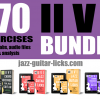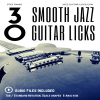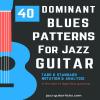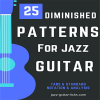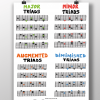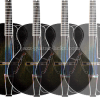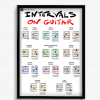
How To Practice Scales On Guitar
- By jazz-guitar-licks
- On 2016-10-27
- In Jazz Guitar Lessons
- 0 comments
You'll find in this lesson some tips and trick for practicing scales, enrich and develop your playing or simply warming-up before a gig.
4 Directions
The "4 directions" technique consists of playing ascending and descending scales and mixing these two directions together. The first direction is to play the scales in the twelve keys in ascending movement (up & up). From the lowest to the highest note of the guitar.
The second direction is down and down, just play the twelve keys starting from the lowest to the highest note.
The two other directions are a mix of the two previous movements: Up & down and of course down and up.
The Circle of Fourths
 The circle of fourths (or circle of fifths) provides the possibility to play all the notes of the western music. Every note resolves to another note a fourth above it. In other words, by following the circle of fourths, you play all the notes separated from each other by five semitones (a fourth).
The circle of fourths (or circle of fifths) provides the possibility to play all the notes of the western music. Every note resolves to another note a fourth above it. In other words, by following the circle of fourths, you play all the notes separated from each other by five semitones (a fourth).
Playing scales following the circle of fourths should be a part of your daily training. It is a great way to know your guitar fretboard. Keep in mind that each note of the circle of fourths can be the root of a scale. Referring to the picture on the left, you must play any scale following this order:
C - F - Bb - Eb - Ab - Db - F# - B - E - A - D - G
You can even apply the four directions to any scale you want to learn (Dorian, Mixolydian, diminished, etc.) following the circle of fourths. For example, with the major scale: C (up), F (down), Bb (up), Eb (down), etc.
Intervals
In music theory an interval is the distance between two notes. Without going into details, the main intervals are named: seconds (2 notes), thirds (3 notes), fourths (4 notes), fifths (5 notes), sixths (6 notes), sevenths (7 notes) and octaves (8 notes).
They can be qualified using the terms "perfect" (P), "minor" (m), "major" (M), "augmented" (A) and "diminished" (d). All this to say that you can practice scales by playing intervals. Something much more musical will come of it.
Let's take an example with the C major scale once again. This scale scale contains the following notes : C-D-E-F-G-A-B. Imagine that you want to play it in intervals of thirds, this would give C-E ; D-F; E-G; F-A; G-B; A-C and so on.
Just the once is not hurt, you must apply the four directions technique to the intervals of the scale you want to master. The four examples below show you how to play the major scale in thirds following the four directions.
You can now repeat these patterns with the scales you want to master with the intervals of your choice.
Triads
A triad is a set of three notes which, when they are stacked in thirds, forms a chord. By playing these notes one by one you get triad arpeggios. Like chords, there are different types of triads, so different formulas to remember:
- Minor triad : 1-b3-5
- Major triad : 1-3-5
- Diminished triad : 1-b3-b5
- Augmented triad : 1-3-#5
As you can see they are all made up of a root (1), a minor or a major third (3 / b3) and a perfect, diminished or augmented fifth (5 / b5 / #5). Why it is so important to learn triads ? Because scales are a combination of different triads.
If you look closely to the major scale you can ear seven different triads related to each degree of this scale.
| I | Major triad | C | E | G |
| II | Minor triad | D | F | A |
| III | Minor triad | E | G | B |
| IV | Major triad | F | A | C |
| V | Major triad | G | B | D |
| VI | Minor triad | A | C | E |
| VII | Diminished triad | B | D | F |
The two exercises below show how to play diatonic arpeggios on guitar following an up & up and an up & down movement.
In the example above, the C Ionian mode is approached with triad arpeggios. Each triad is played from the lowest to the highest note (up). It is possible, once again, to play these triads in the four directions.
The aim is to find triads of any scale, it is simple. Just take the 1st, 3rd and 5th notes from each tone of the scale you want to develop.
Seventh Arpeggios
Like the previous triad arpeggios, you can do the same with seventh chords also known as tetrads. There are no large difference between triads and seventh chords. Just one note more in the 7th arpeggios.
To build a 7th arpeggio you must add the seventh note to the basic triad. That gives the following chart, still with the C major scale.
| I | Major seventh arpeggio | C | E | G | B |
| II | Minor seventh arpeggio | D | F | A | C |
| III | Minor seventh arpeggio | E | G | B | D |
| IV | Major seventh arpeggio | F | A | C | E |
| V | Dominant seventh arpeggio | G | B | D | F |
| VI | Minor seventh arpeggio | A | C | E | G |
| VII | Minor seventh flat fifth arpeggio | B | D | F | A |
Try to practice by playing only the seven 7th arpeggios of the scale of your choice in the 4 directions once again.
Grouping Notes and Patterns
This technique is to group four notes in order to create original and interesting lines. It is inspired by the most famous pattern (sometimes referred as the Coltrane pattern) that is constructed using the 1st, 2nd, 3rd and 5th degrees of a scale.
The example below consists in applying the 1235 pattern starting on each tone of the C major scale.
You can now create your own patterns (1234, 2351, etc), and obviously play them in the four directions.
-
Guitar Scale Dictionary
This E-book is a printable PDF method including over 700 scale diagrams and formula charts for guitarists. -
Guitar Chord Dictionary
This PDF eBook provides over 550 guitar chord shapes. This is the perfect reference guide to understand how chords are built and how to play them on the guitar neck. -
30 Groovy Jazz Guitar Licks
This downloadable package contains a PDF WITH audio files giving access to 30 groovy guitar phrases mixing jazz, blues and funky licks for beginners. -
172 Arpeggio Shapes For Guitar
This printable PDF is a method dedicated to guitarists of all styles who want to learn build and play the most important types of arpeggios. -
126 Triad Chord Shapes
This handbook for guitar players is intended both for teachers and students. It includes 126 guitar shapes for mastering triads. -
Major Scale Harmonization
This package provides a printable PDF with exercises and audio files to learn how to harmonize the major scale with 3 note chords and their extensions. -
30 Minor Arpeggio Licks
This package includes a printable PDF method containing 30 exercises with tabs, staves and audio files for practicing minor arpeggios on guitar. -
II V I Bundle - 170 Exercises
This bundle contains 4 PDF methods for a total of 170 exercises with tabs, staves, analysis & audio files for practicing scales, arpeggios licks & chords over the 2-5-1 progression. -
Diatonic Licks Bundle
This package contains 120 jazz guitar lines based on diatonic modes as Mixolydian, Dorian and Ionian. PDF format with tabs, audio files and analysis. -
30 Smooth Jazz Guitar Licks
In this package you'll get a printable PDF Method with tabs, notation, analysis, scale shapes and audio files for practicing 30 smooth jazz guitar licks. -
40 II V I Jazz Guitar Licks
This pdf method for guitar contains fourteen 2 5 1 jazz guitar lines with tab, standard notation, analysis, scale charts and audio files. -
50 II-V-I voicings
This printable PDF guitar method provides 50 exercises with audio files, analysis, tab and staves for learning major 2-5-1 chord voicings. -
40 Minor 2 5 1 Chord Voicings
This PDF method contains 40 exercices with tabs, scores and audio files for practicing jazz guitar chords over the minor 2 5 1 progression. -
40 Minor II V I Licks
This guitar method is a printable PDF with tabs, diagrams, theory and audio files providing 40 minor 2 5 1 jazz patterns. -
40 Mixolydian Jazz Guitar Lick
PDF guitar method with tabs, audio files and theory providing 40 dominant jazz guitar lines for teachers and students. -
40 Minor Jazz Guitar Licks
This printable guitar method in PDF format contains 40 easy minor jazz guitar lines based on the Dorian mode. -
40 Major Jazz Guitar Licks
Printable PDF eBook method containing 40 major jazz guitar licks with tab, standard notation and audio files for beginners and intermediates. -
Guitar Walking Bass Lines
This jazz guitar method about walking bass lines and chords is available as a PDF files containing 35 exercises with tabs, analysis and audio files -
101 Dominant Arpeggio Patterns
This printable PDF method provides 101 dominant arpeggio exercises with tab, theory and standard notation for the jazz, blues and rock guitarist. -
49 Essential Jazz Lines
This printable eBook method in PDF format provides 49 jazz solo transcriptions of the greatest jazz musicians. Tab, standard notation, audio files & analysis. -
11 Jazz Blues Studies
11 jazz blues chord studies with tabs, standard notation, analysis, and audio recordings and PDF. -
10 Easy Fingerstyle Blues
This PDF with Tabs and audio files provides 10 easy acoustic fingerstyle blues guitar studies for kids and beginners. -
25 Altered Jazz Guitar Lines
This PDF eBook method contains 25 altered jazz guitar licks with tabs, patterns, scale charts and audio files to master, apply and develop the altered scale. -
40 Blues Dominant Patterns
This printable method is available as a PDF file containing 40 easy dominant jazz-blues guitar lines with tabs, standard notation, analysis, audio files and scale charts. -
25 Pentatonic Licks
This jazz guitar method is an eBook available as a PDF with standard notation, guitar tabs, diagrams, analysis, audio files and backing tracks. You will find in this booklet 25 easy jazz guitar lines with theory using common and rare pentatonic scales. -
25 Soul Jazz Guitar Licks
You will find here an eBook available in PDF containing 25 soul jazz and hard bop guitar licks in the style of Grant Green, Melvin Sparks, George Benson. -
25 Diminished Patterns
This eBook PDF with audio files contains 25 dominant diminished jazz guitar patterns using the half-whole diminished scale and diminished 7th arpeggios. -
6 Tritone substitution licks
This Printable PDF eBook available for free download contains 6 easy jazz guitar licks with tabs/notation, youtube video link and analysis about the tritone substitution. -
10 Minor 7 Arpeggio Patterns
This printable PDF eBook offers 10 easy minor 7 arpeggio patterns with its related YouTube video for beginner guitarists. -
10 Easy Major 7 Arpeggio Licks
This is a printable PDF for beginner jazz guitar players providing 10 easy licks to practice major 7 arpeggios. -
10 Chord Melody Lines
Within this package, you'll discover a set of ten chord melody exercises for beginners. Printable PDFaudio files, a backing track, and a link to the associated YouTube video. -
10 Minor Blues Scale Licks
You'll find here a PDF with 10 easy jazz guitar licks to practice the minor blues scale on guitar.
-
Guitar Arpeggios Poster
This giant guitar poster for any guitar player, student or instructor contains colorful arpeggio diagrams. Giant size 24 x 36 inches (60 x 90 cm). -
Major Scale Modes
This poster is created for music teachers and students, illustrating the structure of the seven modes of the major scale. -
Melodic Minor Modes
This music theory poster available in several sizes shows the construction of the seven modes of the melodic minor scale. -
Harmonic Minor Modes
This music theory poster, offered in various sizes, demonstrates the structure of the seven modes of the melodic minor scale. -
Guitar Scales Poster 24*36
Guitar posters and wall art with eighteen neck diagrams representing the most used scales in music. -
Guitar Chord Poster
This printed color posters contains 63 guitar chord diagrams for jazz players, students, teachers and schools. -
Guitar Modes Poster
Guitar reference posters and wall art about modes of the major scale for guitar teachers, students and music schools. -
Melodic Minor Modes Poster
Educative and decorative giant guitar poster with neck diagrams, interval names about the seven modes of the melodic minor scale. -
Pentatonic Scale Guitar Poster
This guitar reference poster shows the positions and intervals of the major pentatonic scale. -
Guitar Notes Poster
This is a giant poster showing the notes on the guitar fret board and their positions on a musical staff. -
Triads Guitar Poster
This reference poster show the positions and intervals of the main triads used on guitar. This is a useful tool for guitarists, teacher and students. -
Four Archtop Guitars Poster
This is a decorative poster with four archtop jazz guitars. Several size and colors in landscape format available on Teespring and redbubble. -
Intervals On Guitar - Poster
This giant poster for guitar provides neck diagrams with interval positions.
jazz guitar patterns scales guitar scales guitar jazz how to practice scales jazz guitar lesson jazz guitar work out guitar lesson mastering jazz scales
Add a comment























